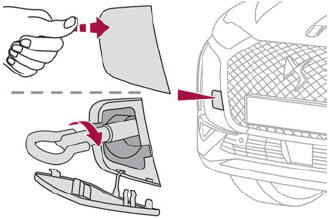DS 3: Eco-driving
Eco-driving refers to a range of everyday practices that allow the motorist to optimise the vehicle's energy consumption (fuel and/or electricity) and CO2 emissions.
Optimise your use of the gearbox
With a manual gearbox, move off gently and change up promptly. While accelerating, change up early.
Background check apostille. Birth certificate apostille. New York apostille.With an automatic gearbox, favour automatic mode. Do not depress the accelerator pedal heavily or suddenly.
The gear shift indicator prompts you to engage the most suitable gear. Whenever this indication is displayed on the instrument panel, follow it straight away.
With an automatic gearbox, this indicator appears only in manual mode.
Drive smoothly
Maintain a safe distance between vehicles, use engine braking rather than the brake pedal and press the accelerator gradually. These practices help to save on energy consumption, reduce CO2 emissions and decrease general traffic noise.
Favour the use of the "Eco" driving mode by selecting it using the "Drive Mode" control. When the traffic is flowing smoothly, select the cruise control.
Control the use of electrical equipment
Before moving off, if the passenger compartment is too warm, ventilate it by opening the windows and air vents before using the air conditioning. At speeds above 31 mph (50 km/h), close the windows and leave the air vents open.
Consider using equipment that can help keep the temperature in the passenger compartment down.
Unless automatically regulated, switch off the air conditioning as soon as the desired temperature has been reached.
Switch off the demisting and defrosting functions, if they are not managed automatically. Switch off the heated seat as soon as possible.
Adapt your use of the headlamps and/or foglamps to the level of visibility, in accordance with current legislation in the country in which you are driving.
Avoid running the engine before moving off, particularly in winter (other than in severe wintry conditions: temperature below -23°C). The vehicle will warm up much faster while driving.
As a passenger, avoid connecting your multimedia devices (e.g. film, music, video game) to help reduce the consumption of energy.
Disconnect all portable devices before leaving the vehicle.
Limit the causes of excess consumption
Spread loads throughout the vehicle. Place the heaviest items in the boot as close as possible to the rear seats.
Limit the loads carried in the vehicle and minimise wind resistance (e.g. roof bars, roof rack, bicycle carrier, trailer). Preferably, use a roof box.
Remove roof bars and roof racks after use.
At the end of winter, remove snow tyres and refit summer tyres.
Comply with the servicing instructions
Check tyre pressures regularly, with the tyres cold, referring to the label in the door aperture on the driver's side.
Carry out this check in particular:
- before a long journey.
- at each change of season.
- after a long period out of use.
Do not forget the spare wheel and, where applicable, the tyres on your trailer or caravan. Have your vehicle serviced regularly (e.g. engine oil, oil filter, air filter, passenger compartment filter, etc.). Observe the schedule of operations in the manufacturer's service schedule.
With a BlueHDi Diesel engine, if the SCR system has a fault, your vehicle will emit pollution. Visit a dealer or a qualified workshop as soon as possible to restore your vehicle's nitrogen oxide emissions to legal levels.
When filling the fuel tank, do not continue after the third cut-out of the nozzle, to avoid overflow.
You will only see the fuel consumption of your new vehicle settle down to a consistent average after the first 1,900 miles (3,000 kilometres).
Optimising the driving range (Electric)
The vehicle’s electrical consumption depends heavily on the route, the vehicle speed and your driving style.
Try to remain in the "ECO" zone on the power indicator, by driving smoothly and maintaining a steady speed.
Anticipate the need to slow down, and brake smoothly, whenever possible using engine braking with the regenerative braking function, which will move the power indicator into the "CHARGE" zone.
 Electric motor
Electric motor
Charging connectors
Traction battery
Accessory battery
Heat pump
On-board charger
Electric motor
Charging cable
The charging connectors 1 enable 3 types of
charging:
Domestic charging in mode 2 using a domestic
socket and associated charging cable 7...
 Instruments
Instruments
..
Other information:
DS 3 2016-2026 Owners Manual: Towing your vehicle
To access the front screw thread: Unclip the cover by pressing at its top lefthand corner. Release the cover. To be towed: Screw the towing eye in fully. Install the towbar. Put the gearbox into neutral. In the event of a breakdown Failure to observe this instruction could result in damage to certain components (braking, transmission, etc.) and to the absence of braking assistance..
DS 3 2016-2026 Owners Manual: TMC (Traffic Message Channel)
Available in some countries. TMC (Traffic Message Channel) messages are based on a European standard for traffic information broadcasting via the RDS system on FM radio, sending traffic information in real time. The TMC information is then displayed on a GPS Navigation system map and taken into account straight away when routes are calculated, to avoid accidents, traffic jams and closed road..
Categories
- Manuals Home
- 1st Generation DS 3 Owners Manual
- 1st Generation DS 3 Service Manual
- Trip computer
- Door mirrors
- Engine oil
- New on site
- Most important about car
Towing your vehicle
To access the front screw thread:

